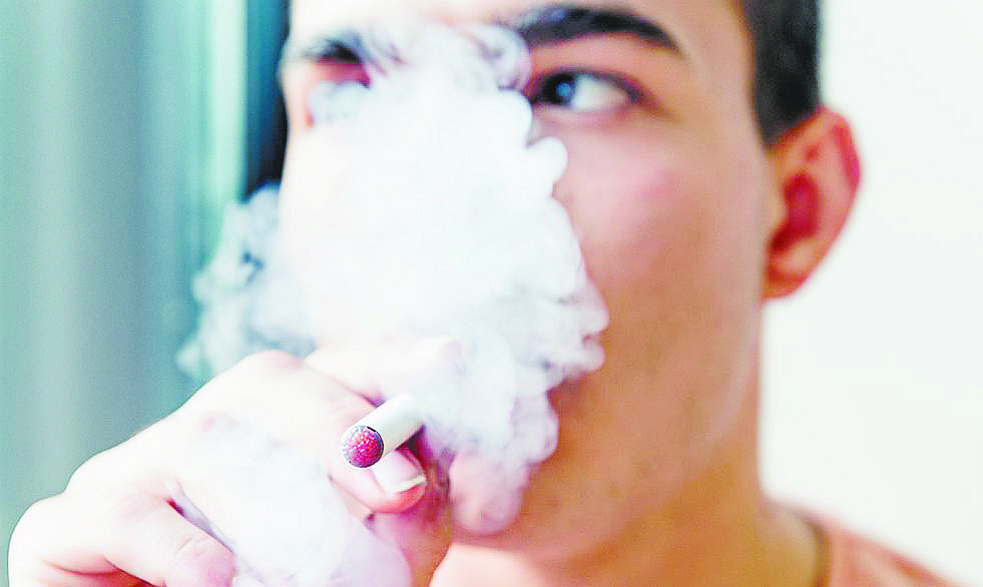Read the complete state and local results from the 2014 Healthy Youth Survey.
Nearly a quarter of high school seniors in Clark County are using electronic cigarettes and other vaping devices — more than any other nicotine delivery method, according to the recently released 2014 Healthy Youth Survey.
The recent survey revealed a significant increase in e-cigarette use among teens in Clark County and across the state in the past two years. Meanwhile, Clark County teens’ marijuana use remained steady — although their perceived risk of marijuana use dropped — and youth drinking declined.
The Healthy Youth Survey is administered statewide every two years to students in sixth, eighth, 10th and 12th grades. Survey answers are voluntary and anonymous. The October 2014 survey results were released Thursday.
In 2014, 24 percent of high school seniors said they had used e-cigarettes or vape pens in the previous 30 days. In 2012, just 5 percent of seniors said they had recently used e-cigarettes (the 2012 survey question did not include vape pens). Seniors used e-cigarettes more often than cigarettes, cigars, candy-flavored tobacco, hookah and smokeless tobacco.
The increase in e-cigarette use was similar among 10th-graders (from 4 percent in 2012 to 21 percent in 2014) and eighth-graders (from 2 percent in 2012 to 10 percent in 2014).
The popularity of vaping devices among youth of all ages is higher in Clark County than the statewide rate: about 21 percent in Clark County compared to 18 percent statewide. In 2012, 4 percent of Clark County youth said they used e-cigarettes.
“It’s very alarming,” said Theresa Cross, health educator for the Clark County Public Health’s chronic disease prevention program. “Vaping is becoming more popular. … Young people are very aware that smoking isn’t good for your health, but vaping doesn’t have that same impression.
“They’re becoming just as addicted to nicotine (through vaping) as they would with these other products,” she added.
Marijuana risks
Marijuana use among Clark County teens remained steady from 2012 to 2014, but fewer teens reported that they think there are risks to using the drug.
The majority of high school students (70 percent of seniors and 60 percent of 10th-graders) said there was no risk or little risk to trying marijuana once or twice, according to the 2014 survey. In 2014, about 46 percent of seniors said there was no risk or little risk to regularly using marijuana (once or twice per week) — up from 36 percent in 2010, according to the survey.
The 2014 survey also asked students about their habits regarding marijuana use and driving.
Nearly 18 percent of Clark County youth and 19 percent of youth statewide said they have ridden in a car driven by someone who had been using marijuana. About 17 percent of Clark County seniors said they have driven a car within three hours of using marijuana.
“We’ve got to ring the alarm bell, because teens are telling us in their own terms that they don’t consider marijuana use to be risky and because they’re being duped to start ‘vaping,’ ” said Secretary of Health John Wiesman in a news release. “We’ve got to take the lessons learned about tactics that helped curb tobacco and alcohol use, and put them to good use educating our kids about risks of using other substances.”
Alcohol
Youth alcohol consumption continued its downward trend in Clark County, according to the report.
In 2014, 34 percent of seniors, 20 percent of 10th-graders and 9 percent of eighth-graders said they had drunk alcohol in the previous 30 days. In 2012, 36 percent of seniors, 23 percent of 10th-graders and 11 percent of eighth-graders were drinking alcohol in the same time period, according to the survey.
In 2014, about a quarter of high school seniors reported binge drinking, or drinking three or more days in the previous month, and 9 percent reported driving after drinking alcohol. Eighteen percent said they rode with a driver who had been drinking. Those rates were nearly the same in 2012.
“It underscores the need for continued public health and public education of the danger of these products for young people,” Cross said. “We take our attention away, or our foot off the hose, and the use, the problems don’t go away.”




